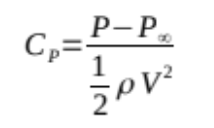The pressure coefficient is defined by the ratio between the static pressure difference and the dynamic pressure (pictured): Where P is the static pressure [Pa], P∞ is the reference static pressure [Pa], ρ is the density [kg/m3], and V is the velocity [m/s]. Using the primary dimensions and their units, show that the pressure coefficient is dimensionless.
The pressure coefficient is defined by the ratio between the static pressure difference and the dynamic pressure (pictured): Where P is the static pressure [Pa], P∞ is the reference static pressure [Pa], ρ is the density [kg/m3], and V is the velocity [m/s]. Using the primary dimensions and their units, show that the pressure coefficient is dimensionless.
International Edition---engineering Mechanics: Statics, 4th Edition
4th Edition
ISBN:9781305501607
Author:Andrew Pytel And Jaan Kiusalaas
Publisher:Andrew Pytel And Jaan Kiusalaas
Chapter9: Moments And Products Of Inertia Of Areas
Section: Chapter Questions
Problem 9.46P
Related questions
Question
The pressure coefficient is defined by the ratio between the static pressure difference and the dynamic pressure (pictured):
Where P is the static pressure [Pa], P∞ is the reference static pressure [Pa], ρ is the density [kg/m3], and V is the velocity [m/s]. Using the primary dimensions and their units, show that the pressure coefficient is dimensionless.

Transcribed Image Text:Р-Р,
Cp=.
ov²
Expert Solution
This question has been solved!
Explore an expertly crafted, step-by-step solution for a thorough understanding of key concepts.
Step by step
Solved in 2 steps with 2 images

Recommended textbooks for you

International Edition---engineering Mechanics: St…
Mechanical Engineering
ISBN:
9781305501607
Author:
Andrew Pytel And Jaan Kiusalaas
Publisher:
CENGAGE L

International Edition---engineering Mechanics: St…
Mechanical Engineering
ISBN:
9781305501607
Author:
Andrew Pytel And Jaan Kiusalaas
Publisher:
CENGAGE L